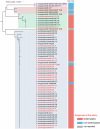Corynebacterium parakroppenstedtii secretes a novel glycolipid to promote the development of granulomatous lobular mastitis
- PMID: 39428541
- PMCID: PMC11491465
- DOI: 10.1038/s41392-024-01984-0
Corynebacterium parakroppenstedtii secretes a novel glycolipid to promote the development of granulomatous lobular mastitis
Abstract
Granulomatous lobular mastitis (GLM) is a chronic idiopathic granulomatous mastitis of the mammary gland characterized by significant pain and a high propensity for recurrence, the incidence rate has gradually increased, and has become a serious breast disease that should not be ignored. GLM is highly suspected relative to microbial infections, especially those of Corynebacterium species; however, the mechanisms involved are unclear, and prevention and treatment are difficult. In this study, we demonstrated the pathogenicity of Corynebacterium parakroppenstedtii in GLM using Koch's postulates. Based on the drug sensitization results of C. parakroppenstedtii, and utilizing a retrospective study in conjunction with a comprehensive literature review, we suggested an efficacious, targeted antibiotic treatment strategy for GLM. Subsequently, we identified the pathogenic factor as a new type of glycolipid (named corynekropbactins) secreted by C. parakroppenstedtii. Corynekropbactins may chelate iron, cause the death of mammary cells and other mammary -gland-colonizing bacteria, and increase the levels of inflammatory cytokines. We further analyzed the prevalence of C. parakroppenstedtii infection in patients with GLM. Finally, we suggested that the lipophilicity of C. parakroppenstedtii may be associated with its infection route and proposed a possible model for the development of GLM. This research holds significant implications for the clinical diagnosis and therapeutic management of GLM, offering new insights into targeted treatment approaches.
© 2024. The Author(s).
Conflict of interest statement
A. F. applied a patent about bacterial detection, other authors declared no competing interests.
Figures






References
-
- Kessler, E. & Wolloch, Y.Granulomatous mastitis: a lesion clinically simulating carcinoma. Am. J. Clin. Pathol.58, 642–646 (1972). - PubMed
-
- Martinez-Ramos, D. et al. Idiopathic granulomatous mastitis: A systematic review of 3060 patients. Breast J.25, 1245–1250 (2019). - PubMed
-
- Azizi, A. et al. Idiopathic granulomatous mastitis: Management and predictors of recurrence in 474 patients. Breast J.26, 1358–1362 (2020). - PubMed
Publication types
MeSH terms
Substances
LinkOut - more resources
Full Text Sources

